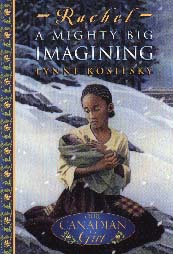| ________________ CM . . .
. Volume VIII Number 5 . . . . November 2, 2001
excerpt:
Rachel and her pregnant mother, Sukey, are en route to a free life in Nova Scotia! With Titan, Rachel's stepfather, they had escaped from their "patriot" landowner during the American War of Independence and worked for the British soldiers in exchange for a promise of freedom and transport to land of their own. It is, however, late autumn; the land will not be granted until spring, and, in the meantime, their "house" in Birchtown, N.S., is a three-coffin-sized, three-foot-deep hole in the ground, with a bit of superstructure and a roof, situated just around the bay from the white community of Shelburne where Titan can get work building other people's houses for eightpence a day. It's cold, and it gets colder. Sukey has her baby. That makes four of them in their hole in the ground, and both mother and baby get sick. Luckily, Rachel is befriended by an Indian girl who not only gives her moccasins and whose mother cures the coughs of the two sick ones, but she listens to her story, the only thing Rachel has to give in return for all her kindness. By winter's end, Rachel has determined that freedom may be costly, but never will she return to being owned again, and, what's more, she is going to learn to read and write. After all, she is free! Freedom is the theme of this story. The picture facing the opening chapter is of the handbill offering a reward for the return of the family: ten pounds for Titan, five for Sukey and three for Rachel. Not that any of them could have read it - it was against the law to teach slaves to read or write. In her first winter, Rachel discovers that freedom consists not only of being able to think of learning such things, but in knowing her worth and that it is not impossible for a "Nigra" to be smarter than a white. Rachel has learned a lot in that time, and we have learned with her. The story carries the reader along and is written at a level that children wanting to move from picture books to chapter books should be able to manage on their own. The illustrations are black-and-white, but very appealing, and presumably by Ron Lightburn, although he gets credit only for the picture on the cover. There have been several books written on the Underground Railway and the escape of slaves in the nineteenth century; it is good to learn that Canada was a refuge long before that. Recommended. Mary Thomas works in two elementary school libraries in Winnipeg, MB, and is pleased that historical fiction is having a bit of a renaissance in children's literature.
To comment on this
title or this review, send mail to cm@umanitoba.ca.
Copyright © the Manitoba Library Association. Reproduction for personal
use is permitted only if this copyright notice is maintained. Any other
reproduction is prohibited without permission.
Published by NEXT REVIEW | TABLE OF CONTENTS FOR THIS ISSUE - November 2,
2001.
AUTHORS | TITLES | MEDIA REVIEWS | PROFILES | BACK ISSUES | SEARCH | CMARCHIVE
| HOME
|
